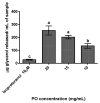Pomegranate Oil's Potential as an Anti-Obesity Ingredient
- PMID: 35956908
- PMCID: PMC9370579
- DOI: 10.3390/molecules27154958
Pomegranate Oil's Potential as an Anti-Obesity Ingredient
Abstract
In recent years, pomegranate oil has obtained more attention due to its content of conjugated linolenic acids and possible application in the prevention of many diseases. The purpose of this work was to evaluate the potential ability of pomegranate oil to modulate obesity-related metabolism and immune response using in vitro models. In this regard, pomegranate oil was characterized in terms of fatty acids profile, tocopherols and phytosterols, and antioxidant capacity. After evaluation of the safety profile, pomegranate oil's capacity to modulate obesity-related metabolism was evaluated through adipolysis and adipokines secretion quantification in 3T3-L1 differentiated adipocytes and hepatic lipid accumulation assay in Hep G2 hepatocytes. The immunomodulatory activity was evaluated in Caco-2 cells by quantification of pro-inflammatory cytokines IL-6, IL-8, and TNF-α. This oil showed high antioxidant capacity and was mainly composed of conjugated fatty acid, namely punicic acid. Its chemical composition was responsible for its capacity to reduce the lipid accumulation in Hep G2 cells and 3T3-L1 differentiated adipocytes. In short, pomegranate oil shows great potential for the development of functional foods and nutraceuticals targeting obesity.
Keywords: conjugated linolenic acids; lipid metabolism; nutraceuticals.
Conflict of interest statement
The authors declare no conflict of interest.
Figures





Similar articles
-
Anti-obesity potential of a yogurt functionalized with a CLNA-rich pomegranate oil.Food Res Int. 2023 Nov;173(Pt 2):113364. doi: 10.1016/j.foodres.2023.113364. Epub 2023 Aug 7. Food Res Int. 2023. PMID: 37803704
-
Anti-inflammatory effect of two pomegranate seed oils obtained by green technologies in Caco-2 cells using the bioaccessible fraction from in vitro gastrointestinal digestion.Food Res Int. 2023 Mar;165:112475. doi: 10.1016/j.foodres.2023.112475. Epub 2023 Jan 9. Food Res Int. 2023. PMID: 36869488
-
Physicochemical characterization of oil, antioxidant potential, and phenolic profile of seeds isolated from Tunisian pomegranate (Punica granatum L.) cultivars.J Food Sci. 2021 Mar;86(3):852-859. doi: 10.1111/1750-3841.15636. Epub 2021 Feb 13. J Food Sci. 2021. PMID: 33580521
-
Punicic acid: A potential compound of pomegranate seed oil in Type 2 diabetes mellitus management.J Cell Physiol. 2019 Mar;234(3):2112-2120. doi: 10.1002/jcp.27556. Epub 2018 Oct 14. J Cell Physiol. 2019. PMID: 30317607 Review.
-
Palm fruit chemistry and nutrition.Asia Pac J Clin Nutr. 2003;12(3):355-62. Asia Pac J Clin Nutr. 2003. PMID: 14506001 Review.
Cited by
-
Potential Biological Properties of Lycopene in a Self-Emulsifying Drug Delivery System.Molecules. 2023 Jan 26;28(3):1219. doi: 10.3390/molecules28031219. Molecules. 2023. PMID: 36770886 Free PMC article.
-
The Role of Unsaturated Fatty Acid-Rich Dairy Products in Adipocyte Metabolism.Molecules. 2024 Nov 21;29(23):5502. doi: 10.3390/molecules29235502. Molecules. 2024. PMID: 39683663 Free PMC article.
-
Understanding the Anti-Obesity Potential of an Avocado Oil-Rich Cheese through an In Vitro Co-Culture Intestine Cell Model.Molecules. 2023 Aug 7;28(15):5923. doi: 10.3390/molecules28155923. Molecules. 2023. PMID: 37570893 Free PMC article.
-
Phytochemicals and pharmacology of pomegranate (Punica granatum L.): nutraceutical benefits and industrial applications: a review.Front Nutr. 2025 Mar 27;12:1528897. doi: 10.3389/fnut.2025.1528897. eCollection 2025. Front Nutr. 2025. PMID: 40212725 Free PMC article. Review.
-
Bigels as Delivery Systems of Bioactive Fatty Acids Present in Functional Edible Oils: Coconut, Avocado, and Pomegranate.Gels. 2023 Apr 21;9(4):349. doi: 10.3390/gels9040349. Gels. 2023. PMID: 37102961 Free PMC article.
References
-
- Jeria N., Cornejo S., Prado G., Bustamante A., Garcia-Diaz D.F., Jimenez P., Valenzuela R., Poblete-Aro C., Echeverria F. Beneficial Effects of Bioactive Compounds Obtained from Agro-Industrial By-Products on Obesity and Metabolic Syndrome Components. Food Rev. Int. 2022:1–30. doi: 10.1080/87559129.2021.2013498. - DOI
-
- Greevenbroek M.M., Schalkwijk C., Stehouwer C.D.A. Obesity-associated low-grade inflammation in type 2 diabetes mellitus: Causes and consequences. Neth. J. Med. 2013;71:174–187. - PubMed
MeSH terms
Substances
Grants and funding
LinkOut - more resources
Full Text Sources

